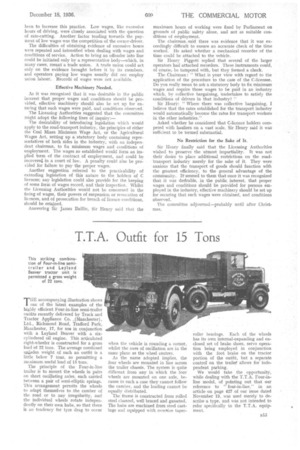T.T.A. Outfit for 15 Tons
Page 47

If you've noticed an error in this article please click here to report it so we can fix it.
THE accompanying illustration shows one of the latest examples of the highly efficient Four-in-line semi-trailer outfits recently delivered by Truck and Tractor Appliance Co. _(Manchester), Ltd., Richmond Road, Trafford Park, Manchester, 17, for use in conjunction with a Leyland Beaver with a sixcylindered oil engine. This articulated eight-wheeler is constructed for a gross load of 22 tons. The average combined tudaden weight of such an outfit is a little below 7 tons, so permitting a maximum useful load of 15 tons.
The principle of the Four-in-line trailer is to mount the wheels in pairs on short oscillating axles, each carried between a pair of semi-elliptic springs. This arrangement permits the wheels to adapt themselves to the camber of the road or to any irregularity, and the individual wheels rotate independently on their own hubs, so that there is no tendency for tyre drag to occur when the vehicle is rounding a corner, whilst the axes of oscillation are in the same plane as the wheel centres, As the name adopted implies, the four wheels are mounted in line across the trailer chassis. The system is quite different from any in which the four wheels are mounted on one axle, because in such a case they cannot follow the camber, and the loading cannot be equally distributed.
The frame is constructed from rolled steel channel, well braced and gusseted. The hubs are machined from steel Castings and equipped with oversize taper roller bearings. Each of the wheels has its own internal-expanding and enclosed set of brake, shoes, servo operation being employed in conjunction with the foot brake on the tractor portion of the outfit, but a separate control on the trailer allows for independent parking.
We would take the opportunity, while dealing with the T.T.A. Four-inline model, of pointing out that our reference to "four-in-line," in an article on page 427 of our issue dated November 13, was used merely to describe a type, and was not intended to refer specifically to the T.T.A. equipment.




















































































